|
menu
|
 |
|
 |
 |
|
THE
BRITISH HALLMARKING SYSTEM FOR GOLD, SILVER AND PLATINUM
|
|
|
STANDARD MARKS
|
Hallmarking of silverware represents one of the first
Quality Assurance System adopted by man. Since 1300 any silverware
produced in England should be marked. The system evolved in the time in
order to make possible to track the entire process of control and in
particular to identify the person in charge for the standard control and
the hallmarking.
In bygone days fraudulent activities in hallmarking
silver and gold were punished with death, but the penalty it is still
significant today (till ten years of prison).
The first guarantee marks used in England was the
leopard head, that was impressed on silverware made of alloy containing at
least 925 ppt of silver (sterling standard).
During the XV century, to prevent the bad practice of
marking as sterling under standard items with a possible detriment of the
silver standard use for coin (silverware could be converted in coin
without assaying if marked with the leopard head), some change were
promoted. Hallmarking operations were moved to the Goldsmith Hall of
London, where the Workshipful Company of Goldsmiths was established, and
put under the control of an Assay Master (then the term hallmarking).
In 1544 Henry VIII moved the hallmarking operation from
the Goldsmith hall putting them under the direc control of the Crown. A
new marks, the lion passant, was introduced to demonstrate the Royal
supremacy to preserve the silver standard. In 1550 hallmarking operation
moved back to the Goldsmith Hall, under the control of the Workshipful
Company of Goldsmith, but the new mark was kept becoming soon the guarantee for the sterling standard. The leopard head was not disused and
became the symbol of the London Assay Office.
The leopard head was crowned until 1820. The marks was
also used during the XVIII and XIX century by some provincial Offices
together with their own marks.
The lion passant was crowned between 1544 and 1549 and
it was not more "guardant" since 1820 (at least in London).
The lion rampant was used in Scotland to denote the
sterling standard instead of the lion passant: in Glasgow between 1819 and
1964 (year when the Office closed down), and in Edinburgh between 1975 and
1999 when the mark for sterling silver was unified thoroughly the UK.
Before 1975 (and since 1759) the sterling mark for silver assayed in
Edinburgh was the thistle.
In Ireland, at least since 1633, a crowned harp is in
use to denote sterling standard.
In 1697, to prevent the practice of producing
silverware using as base metal silver obtained by melting sterling coins,
the silver standard for silverware was increased up to 958,4 ppt
(Britannia standard or high standard). The female figure of the Britannia
was introduced to denote this new standard instead of the lion passant.
Also the symbol of the London Assay Office was changed by adopting the
heraldic figure of the lion head erased. At the same time silversmiths
were imposed to register new maker marks.
This new rules for hallmarking was compulsory until
1720, when the sterling standard was restored and the lion passant and the
leopard head reintroduced. The Britannia standard was nor repealed and its
optional use was allowed until today. Since 1999 the Britannia standard
silverware was marked with the Britannia but not with the lion head erased
because the mark for the London Assay Office was unified (the leopard head
for both standards).
The Britannia standard was used in London and in some
provincial town but never in
Ireland, Scotland. Some confusion can
arise for silver marked in Ireland where a mark similar to the Britannia
(the Hibernia) was in use between 1730 and 1807 as duty mark. After the
Union Act of Ireland with England and Scotland and the adoption of the
English system for hallmarking, the Hibernia became the symbol of the
Dublin Assay Office.
Between 1784 and 1890 five marks are struck on
silver crafted and hallmarked in the UK: the maker mark, the sterling
standard mark, the town mark, the duty mark and the date letter. There are
some exception for small articles and detachable parts of silverware like tea
and coffee pot which were occasionally only partially hallmarked.
^Top
|
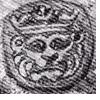
Crowned
leopard head impressed on a silver article of XV century, standard
mark for sterling silver between 1300 and 1544


Lion
passant: standard mark for sterling silver from 1544 to 1999 (after 1999
is an optional mark)
Up:
guardant: in use before 1820 (London) and 1975 (Birmingham and
Sheffield)
Down:
not guardant: in use after before 1820 (London) and 1975 (Birmingham
and Sheffield)
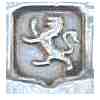
Lion
rampant in use in Scotland instead of the lion passant:
Glasgow from 1819 to 1964 and Edinburgh from 1975 to 1999

Thistle
in use in Scotland instead of the lion passant. Edinburgh from 1759 to 1975

Crowned
harp in use in Ireland as standard mark for sterling silver since 1637
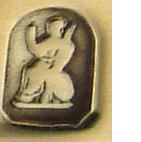
Britannia,
standard mark for silver fitness of 958,4 ppt (compulsory between
1686 and 172)
|
Maker Marks
|
In 1360, in order to reduce the production of under
standard silverware, all silversmith were ordered to register a mark at
the local Assay Office and struck it on all they works. During XIV and XV
century, due to the diffused illiteracy, marks were constituted by symbols
and, sometime, rebus, solving them one can understand the name of the
silversmith. Since the XV century, marks formed by the initial letters of
the silversmith come into use. During the period of the Britannia standard
(1696-1720) the silversmiths were ordered to register new marks with the
two first letter of their surname. Since 1720, in concomitance with the
reintroduction of the sterling standard, and definitively with an act of
1739 all the older marks were destroyed and replaced by new marks
reporting the silversmith initials.
In more recent time (from the beginning of XIX century) the form of the maker
mark becomes more
complicated, including, ii the case of enterprises, the initials of all
the consociated silversmiths.

An
example of maker marks formed by a symbol (on the left) (Robert Durand?)
impressed on a silverware hallmarked in London in 1565
A
collection of maker marks is reported at the page The
slversmiths.
^Top
|

An
example of maker mark formed by the first two letter of the silversmith
surname, in use during the period of the Britannia standard (1696-1720) (Paul de Lamerie)

An
example of maker mark formed by the initial of the silversmith, in
use before and after the period of the Britannia standard Paul de Lamerie)
|
Date Letter
|
In 1478 a third mark, reporting a letter of the
alphabet to be change each year at the beginning of the month of May, was
introduced. The use was not in the intention to allow the posterity to
identify the year where the silver was hallmarked, but those to make
identifiable the Assay Master in charge at that time, in order to
comminate him a penalty in case of marks struck on under standard
silverware.
In London only 20 letter were used (all except J, W, X,
Y e Z); in Birmingham all the alphabet; in Edinburgh all the letter except
J. In Sheffield, in the period between the opening of the Assay Office
(1773) and 1824 the date letter randomly changed. In Glasgow the use of
the date letter was suspended for most the XVIII century
The font of the
letter was changed each cycle, combining the use of capital and lower
letters and different shape of punches, in order to cover with different
combination all the period of time th Assay master was in charge.
Since 1975 the date letter was unified for all the survived
Assay Office in the UK (London, Birmingham, Sheffield and Edinburgh), and
changed at the beginning of January each year. Since 1999 the use of the
date letter became an optional.
^Top
|

London
1697

London
1758

London
1792

London
1838

London1908 |
TOWN MARKS
|
In
1478 the town mark indicating the Assay Office were the silversmith was
registered, began to be struck together with the maker mark. The town
mark is often representing the City Arms and its use was intended to help
in the i-identification of the silversmith

 

Crowned
leopard head in use as London mark since 1550 except the period between
1696 and 1720). After 1820 is not more crowned
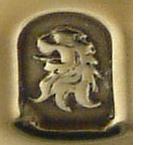
Lion
head erased, in use as London Mark for silver of Britannia standard

 

 
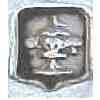 
Some
example of town marks. From the left: Birmingham, Chester,
Exeter, Newcastle, Sheffield, Edinburgh, Glasgow, Dublin
More town marks at the pages Provincial
assay Offices and
The
main Assay Offices
^Top
|
|
DUTY MARKS
|
In 1720, when 'sterling' standard (925 ppt) was
reinstated after the compulsory use of Britannia standard (958,4 ppt), a 6
pence duty per troy ounce of silver was imposed on silverware production
and trade in UK. An item of about 33 oz (1000 g) as subject to a duty
equalling a 2005 value of about 120/140 dollars, that is to say the same
price requested by a silversmith for its manufacture. The
temptation for a silversmith to "dodge the duty" and keep this
money for himself was consequently very high, in spite of a death sentence
imposed for hallmarks forgery or transposing. Some dishonest silversmiths
used spoons or little salt cellars (paying a small duty for the standard
verification of the Assay Office) cutting their hallmarks and soldering on
pieces of higher weight.
The duty on silver and gold was repealed in 1757 when a
tax for any activity producing and selling silver and gold was introduced.
Since December 1784 a new duty (to support the
expensive for the secession war in the North America but abolished only in
1890), was imposed and a new mark, the profile of the reigning Sovereign
was introduced to demonstrate its payment. So, on silver marked between
1784 and 1890 we can find the profile of George III (1784-1820), George IV
(1821-1830), William IV(1831-1836) and Victoria (1837-1890).
All these marks show the Sovereign profile looking
right with the exception of the mark of George III in use between the
first of December 1784 and the 30th of April 1785 (the so
called "incuse", being impressed in depth on the silver), and
those of Queen Victoria. which are looking left.
Between December 1784 and July 1785 a special marks for
retrieval of the duty paid on exported items (the erected silhouette of
the Britannia) has been in use.
In Ireland the duty was introduced in 1730 and a duty
mark (the Hibernia) was struck on silver to demonstrate its payments. Since 1807
(after the Union Act of Ireland with England and Scotland) and the
adoption of the English system for hallmarking, the Hibernia became the
symbol of the Dublin Assay Office and the current duty marks in use in
England was adopted.
^Top
|

Hibernia,
in use in Ireland as duty marks from 1730 and 1807 and as Dublin Mark
after 1807

Duty
mark during the reign of George III
(1784-1785)

Duty
mark during the reign of George III
(1785-1820)

Duty
mark during the reign of George
IV (1821-1830)

Duty
mark during the reign of William IV
(1831-1836)

Duty
mark during the reign of Queen Victoria (1837-1890)
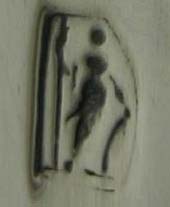
Duty
drowback mark in use between December 1784 and July 1785
|
COMMEMORATIVE AND JUBILEE
MARKS
|
During the XX and XXI some optional commemorative marks
(mainly royal jubilee marks) have been introduced. Jubilee marks are very
similar to duty marks (not to be confused with) as a sovereign profile is
represented. Their have been use in:
- 1936/7 (25th anniversary of George V coronation);
- 1953/4 (coronation of Queen Elizabeth II);
- 1977 (25th anniversary of Queen Elizabeth II coronation and 750th
anniversary of the royal chart for the Goldsmiths' Company;;
- 2002 (anniversary of Queen Elizabeth II coronation);
- 1999/2000 millennium mark (a cross with the number 2000)

Millennium
Mark (1999/2000)
Some
commemorative marks can be found on Irish silver: a revolution jubilee
mark in 1666; commemorative mark for the entrance of Ireland in the EU in
1973; 350th anniversary of the Silversmith Association in 1987,
Dublin city millennium in 1988 and millennium hallmark in 1999/2000.
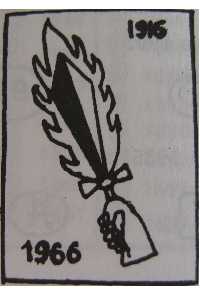

The
revolution Jubilee mark (1916-1966) was struck on gold and silverware
together with the date letter Y, from January to December 1966.
Only 34,715 articles of silverware has been struck with this mark.
^Top
|

Optional
mark for the George V jubilee (1936/7)

Optional
mark for the coronation of Queen Elizabeth II (1953/54)

Optional
mark for the silver jubilee of Queen Elizabeth II (1977)
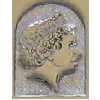
Optional
mark for the gold jubilee of Queen Elizabeth II (2002)
|
THE PRESENT
SYSTEM OF HALLMARKING
|
Since 1975 some change occurred, in particular:
- new standards for silver have been introduced (800 and 999 ppt);
- the silver standard is now struck as Arabic number in a oval;
- the symbol of the Sheffield Assay Office (a crown) was change
adopting the Tudor rose to avoid confusion with the mark used for
gold;
- the date letter was unified for all the survived Assay Office in the
UK (London, Birmingham, Sheffield and Edinburgh), and changed at the
beginning of January each year;
- the sterling mark (thistle) for the Edinburgh Assay Office was
change in the lion rampant;
Since 1999 some more changes have been introduced:
- the sterling mark (lion passant) was adopted by all the Assay
Offices (including Edinburgh, instead of the lion rampant);
- the symbol of the London Assay Office (the leopard head) was also
adopted for the Britannia standard (instead of the lion head erased);
- only the maker mark (now known as sponsor mark) the finesse or standard
(Arabic number in a oval) and Assay Offices marks remain compulsory; other traditional marks (Britannia and lion passant became voluntary
marks;
|
Traditional
name
|
Finesses
in ppt
|
Standard
mark
|
Convention
mark
|
|
|
800
|

|

|
|
Sterling
|
925
|

|

|
|
Britannia
|
958
|

|
|
|
|
999
|

|
Standard
marks in use since 1999
Details
of the new system
Hallmarking
act of 1973 (in force since 1975)
Hallmarking
act of 1998 (in force since 1999)
^Top
|
|
GOLD AND
PLATINUM MARKS
|
Gold (at first 19.5, then 22 and 24 carats) was marked
in the same way as for silver until 1798, with the only difference in the
use of the lion passant also in the period when was in force the Bbritannia
standard (1696-1720). As a consequence of the introduction of a new
fitness for gold (18 carats), a new mark to be impressed on item
conforming to this new standard was introduced (a number equals the carats
and a crown). The crown was usually impressed above the number, bat one can
find some item were this two marks were separately struck.
22 carats gold was marked as for the 18 carats finesses
only since 1844, but always with the number and the crown impressed in
sequence.
Between 1816 and 1844 a rare mark (the sun) for 22
carats gold has been in use at least in London.
In 1854 new gold standard of 9, 12 and 15 carats have
been introduced for commercial reason related to the export of gold item to the
North America.
Since 1933 gold standards are only four (9, 14, 18 and
22 carats). The new marks report the number of carats and the finesses per
unit of gold (e.g.14 followed by .585 for 14 carat gold standard).

Gold
mark on a article made of 9 carats gold bearing the Birmingham
hallmarks for 1899
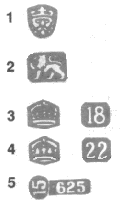
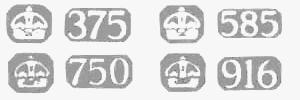
A selection of gold itnesses marks Finesses
marks for gold of
9, 14, 18 e 22 carats (since 1975)
1
19 1/5 carats (1300-1476) and 18 carats (1477-1544)
2
18 carats (1544-1574) and 22 carats (1575-1843)
3 18 carats (1798-1974)
4
22 carats (1844-1974)
5
15 carats (1854-1931)
An
act of 1973 (coming in force in 1975) established that on platinum
metalwork a mark (an orb with a cruise) must be struck when up to
standard of 950 ppt. Gold is now marked with a crown and a number
reporting the finesses in ppt. This system was then modified according to
the following table:
|
|
Traditional
finesses
|
Finesses
in ppt
|
Standard
mark
|
Convention
mark
|
|
GOLD
|
9
Carats
|
375
|

|

|
|
14
Carats
|
585
|

|

|
|
18
Carats
|
750
|

|

|
|
22
Carats
|
916
|

|
|
|
|
990
|

|
|
999
|

|
|
PLATINUM
|
|
850
|

|
|
|
900
|

|
|
950
|

|

|
|
999
|

|
|
^Top
|
|
IMPORT MARKS
|
Since 1842 any silver item imported in the UK must be
checked for the conformity to sterling or Britannia standard, with the
formal exception for items manufactured before 1800. In 1883 a mark (a
capital letter F) was imposed to indicate the foreign origin of the item
(with some exception for small items for which hallmarking can result
difficult). This mark generated some problem, because it was very similar
to a date letter.
In 1904 hallmarking on import silverwares was completely
revised and integrated in 1906 to avoid confusion between the introduced
marks (e.g. for London) and similar trade marks.
|
Office |
symbol
since 1904 |
symbol |
symbol
since 1906 |
symbol |
|
London |
the
sun |
 |
constellation
of Leo |
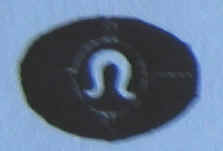 |
|
Birmingham |
a
triangle |
 |
|
|
|
Chester |
an
acorn and two leaves |
 |
|
|
|
Sheffield |
crossed
arrows |
 |
Libra |
 |
|
Edinburgh |
St.
Andrew's cross |
 |
|
|
|
Glasgow |
a
bishop's mitre |

|
double
block F letter inverted |
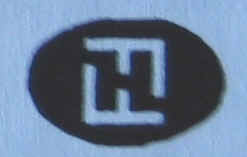
|
|
Dublin |
a
shamrock |

|
boujet |
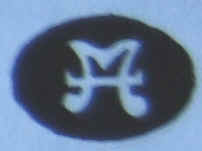
|
In 1976 a common agreement on imported/exported
precious metalwork was subscribed by Austria, Finland, Norway, Sweden,
Switzerland, Portugal and UK, later integrated in 1983. As a consequence of
this agreement a common mark for finesses (convention mark) was
adopted.
Convention marks in force since 1976 in Austria,
Finland, Norway, Sweden, Switzerland, Portugal and UK and since 1999 also
in the Check Republic, Denmark, Ireland and Netherlands.
Although not compulsory, each Country can maintain own town and traditional marks (e.g. the lion passant, the lion
rampant, the date letter, the 1906 import mark, etc.). Special marks (not
reported in the table but available at the link below) are struck on
exported silverware produced in the UK with finesses standards of 800 or
830 ppt, not in use in the UK internal market.
On silver marked with the convention marks no more
control should be dome to within the Countries that signed the agreement.
 

Convention
marks in force since 1976 in Austria, Finland, Norway, Sweden, Switzerland,
Portugal and UK, and since 1999 also in the Check Republic, Denmark,
Ireland, The Netherlands. From the left: silver mark, gold mark and
platinum mark
More
details in the Regulation
of 1983
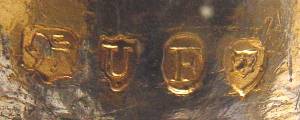
Import
mark (London 1895) in use from 1883 to 1904

Import
mark for Chester, 1909. This
item also bears the mark of Bertold Muller (BM), famous for the import of
German silver based on old style, operating in London and Chester

Import mark
for London 1906 in use since 1906.
^Top
|
|
|
|
 |
